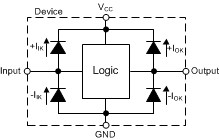JAJSMB7 June 2020 CD54HCT10 , CD74HCT10
PRODUCTION DATA
- 1 特長
- 2 アプリケーション
- 3 概要
- 4 Revision History
- 5 Pin Configuration and Functions
- 6 Specifications
- 7 Parameter Measurement Information
- 8 Detailed Description
- 9 Application and Implementation
- 10Power Supply Recommendations
- 11Layout
- 12Device and Documentation Support
- 13Mechanical, Packaging, and Orderable Information
8.3.3 Clamp Diode Structure
The inputs and outputs to this device have both positive and negative clamping diodes as depicted in Figure 8-1.
CAUTION:
Voltages beyond the values specified in the Section 6.1 table can cause damage to the device. The recommended input and output voltage ratings may be exceeded if the input and output clamp-current ratings are observed.
 Figure 8-1 Electrical Placement of Clamping Diodes for Each Input and Output
Figure 8-1 Electrical Placement of Clamping Diodes for Each Input and Output